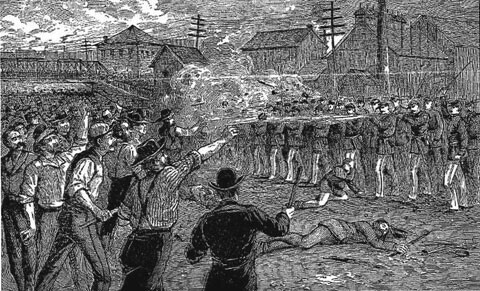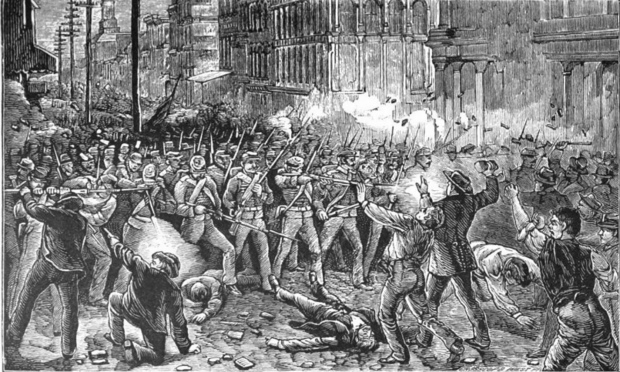MikeDunnAuthor · @MikeDunnAuthor
1705 followers · 3578 posts · Server kolektiva.socialToday in Labor History July 21, 1877: 30,000 Chicago workers rallied on Market Street during the Great Upheaval wave of strikes occurring throughout the country. Future anarchist and Haymarket martyr Albert Parsons spoke to the crowd, advocating the use of the ballot to obtain "state control of the means of production," and urged workers to join the communist Workingmen's Party. Parsons was later abducted by armed men who took him to the police where he was interrogated and informed that he had caused the city great trouble.
The strike wave started in Martinsburg, WV, on July 16, and quickly spread along the railroad lines throughout the country. In Chicago, striking workers from numerous industries took to the streets daily. They shut down the railroads, mills, foundries and many other businesses. They carried banners that said "Life by work, or death by fight". One speaker said, "We must rise up in our might, and fight for our rights. Better a thousand of us be shot down in the streets than ten thousand die of starvation."
On July 26, the protesters threw rocks and fired pistols at the cops, who fired back until they ran out of ammo and were forced them to flee. However, they ran into a detachment of reinforcements and federal troops, sent in by President Hayes. This led to the Battle of the Viaduct, resulting in 15-30 dead strikers and dozens wounded.
In Pittsburgh, 20 striking railroad workers were killed by state troopers during the Great Upheaval. The second book of my “Great Upheaval” trilogy, “Hot Summer in the Smoky City,” takes place in Pittsburgh during the Great Upheaval.
#WorkingClass #LaborHistory #GreatUpheaval #railroad #strike #GeneralStrike #chicago #anarchism #communism #haymarket #police #acab #HistoricalFiction #novel @bookstadon
#workingclass #LaborHistory #greatupheaval #railroad #strike #generalstrike #chicago #anarchism #communism #haymarket #police #acab #historicalfiction #novel
MikeDunnAuthor · @MikeDunnAuthor
1698 followers · 3544 posts · Server kolektiva.socialToday in Labor History July 20 1877: In the midst of the Great Upheaval (AKA Great Train Strike), the Maryland state militia fired on striking railroad workers in Baltimore, killing over 20, including children. The strike had started on July 14, in Martinsburg, WV, at the B&O Railroad yards. It quickly spread into Charleston, WV and Baltimore and Cumberland, MD. In Baltimore, as the 5th Regiment marched toward Camden Station with fixed bayonets on their Springfield rifles, crowds attacked them with bricks. Miraculously, no serious injuries occurred. However, when the 6th Regiment began their march, the crowds drove them off with paving stones and fists. Without orders, they began firing at the crowd, killing several. When the two regiments met at Camden Station, the crowds again hurled stones and bricks, disabling locomotives, tearing up tracks and driving off the engineers. They set fire to railroad cars and buildings and cut the firemen’s hoses when they tried to douse the flames.
The Great Upheaval came in the middle of the Long Depression, one of the worst depressions the U.S. has ever faced. My novel, “Anywhere But Schuylkill,” (hopefully out by year’s end) takes place in the years leading up to the Great Strike and is Part I of “The Great Upheaval” trilogy. I am currently working on Book II: “Red Hot Summer in the Smoky City.”
#WorkingClass #LaborHistory #GreatUpheaval #railroad #baltimore #massacre #children #GeneralStrike #AnywhereButSchuylkill #novel #HistoricalFiction #writer #author @bookstadon
#workingclass #LaborHistory #greatupheaval #railroad #baltimore #massacre #children #generalstrike #anywherebutschuylkill #novel #historicalfiction #writer #author

